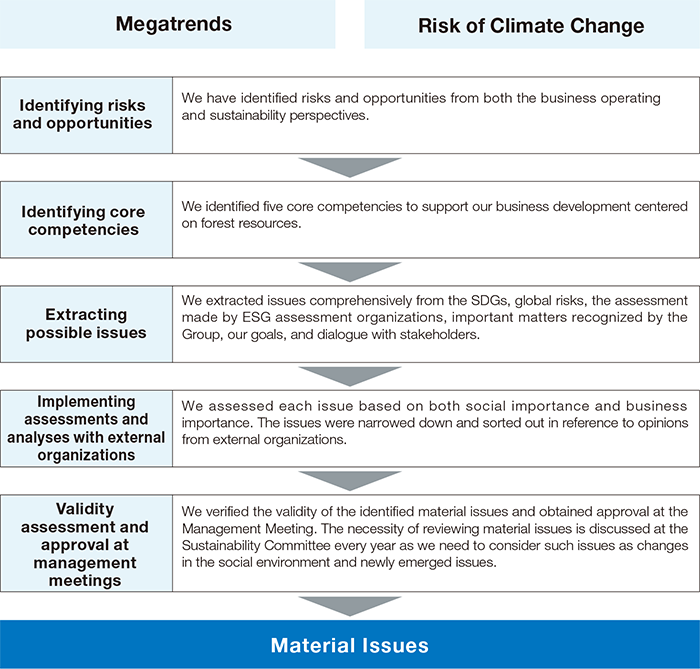Taking into consideration ever-changing social trends, the Oji Group identified opportunities and risks associated with its business as well as material issues utilizing the following process in 2019.
In 2023, we took steps to renew our definition for and the components of material issues and revised the KPIs for enhancing human capital. More recently in 2024, we added KPIs for biodiversity conservation.

| Material Issues | Definitions |
|---|---|
|
Mitigation and adaptation to climate change
|
Contribute to mitigation of climate change by reducing GHG emissions throughout the supply chain and promoting CO2 absorption and fixation by forests. |
|
Sustainable forest management and biodiversity conservation
|
In the forests we own and manage, practice sustainable forest management in harmony with the environment and local communities, utilize forest resources, and achieve the multifunctionality of forests, including biodiversity conservation. |
|
Circular use of resources
|
To prevent resource depletion, promote the effective use of paper and water, which we view as valuable reusable resources. |
|
Responsible raw materials procurement
|
In the supply chain for procurement of all raw materials, pay close attention to environmental and social issues, including human rights, and address them responsibly. |
|
Reduction of environmental burdens
|
Promote waste reduction and purification of wastewater and exhaust gases in the manufacturing process to minimize environmental impact on surrounding areas. |
|
Respect for human rights
|
Do not tolerate human rights violations in any of our business activities. |
|
Enhancing human capital
|
Secure and foster diverse human resources (human capital) necessary for sustainable growth. Establish an environment in which every employee can fully demonstrate their potential and work comfortably. |
|
Ensuring workplace safety and health
|
Ensure the safety and health of all employees and relevant persons. |
|
Supply of safe and secure products
|
Supply safe and secure products worldwide. |
For a summary version ideal for getting a general overview and suitable for printing, please use the PDF version. For more detailed information, please use the web version.
| Components | Key performance indicators (KPIs) (Unless otherwise specified, for FY2030) |
Current value*1 | Major initiatives | Value provided to society | Corresponding SDGs |
|---|---|---|---|---|---|
|
Mitigation and adaptation to climate change
|
|||||
|
|
|
|
|
|
|
|
||||
|
|
||||
|
|
||||
|
Sustainable forest management and biodiversity conservation
|
|||||
|
|
|
|
|
|
|
|
||||
|
|
||||
|
|
||||
|
|
||||
|
Circular use of resources
|
|||||
|
|
|
|
|
|
|
|
||||
|
Responsible raw materials procurement
|
|||||
|
|
|
|
|
|
|
|
||||
|
Reduction of Environmental burdens
|
|||||
|
|
|
|
|
|
|
|
||||
|
|
||||
|
Respect for Human Rights
|
|||||
|
|
|
|
|
|
|
Enhancing Human Capital
|
|||||
|
|
|
|
|
|
|
|
||||
|
|
||||
|
|
||||
|
|
||||
|
|
||||
|
Ensuring Workplace Safety and Health
|
|||||
|
|
|
|
|
|
|
|
||||
|
Supply of safe and secure products
|
|||||
|
|
|
|
|
|